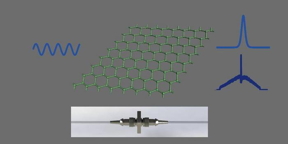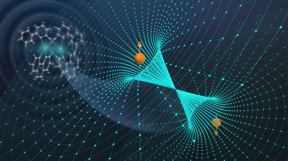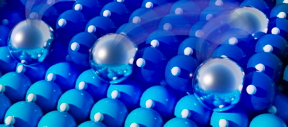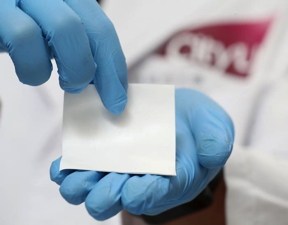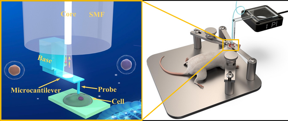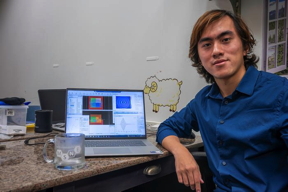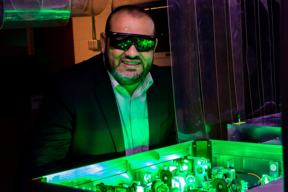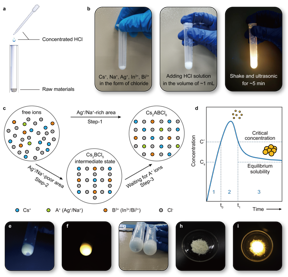Home > Press > The medicine of the future could be artificial life forms
Abstract:
Creating artificial life is a recurring theme in both science and popular literature, where it conjures images of creeping slime creatures with malevolent intentions or super-cute designer pets. At the same time, the question arises: What role should artificial life play in our environment here on Earth, where all life forms are created by nature and have their own place and purpose?
The medicine of the future could be artificial life forms
Copenhagen, Denmark | Posted on October 6th, 2023Associate professor Chenguang Lou from the Department of Physics, Chemistry, and Pharmacy, University of Southern Denmark, together with Professor Hanbin Mao from Kent State University, is the parent of a special artificial hybrid molecule that could lead to the creation of artificial life forms. They have now published a review in the journal Cell Reports Physical Science on the state of research in the field behind their creation. The field is called "hybrid peptide-DNA nanostructures," and it is an emerging field, less than ten years old.
Lou's vision is to create viral vaccines (modified and weakened versions of a virus) and artificial life forms that can be used for diagnosing and treating diseases.
"In nature, most organisms have natural enemies, but some do not. For example, some disease-causing viruses have no natural enemy. It would be a logical step to create an artificial life form that could become an enemy to them," he says.
Similarly, he envisions such artificial life forms can act as vaccines against viral infection and can be used as nanorobots or nanomachines loaded with medication or diagnostic elements and sent into a patient's body.
"An artificial viral vaccine may be about 10 years away. An artificial cell, on the other hand, is on the horizon because it consists of many elements that need to be controlled before we can start building with them. But with the knowledge we have, there is, in principle, no hindrance to produce artificial cellular organisms in the future," he says.
What are the building blocks that Lou and his colleagues in this field will use to create viral vaccines and artificial life? DNA and peptides are some of the most important biomolecules in nature, making DNA technology and peptide technology the two most powerful molecular tools in the nanotechnological toolkit today. DNA technology provides precise control over programming, from the atomic level to the macro level, but it can only provide limited chemical functions since it only has four bases: A, C, G, and T. Peptide technology, on the other hand, can provide sufficient chemical functions on a large scale, as there are 20 amino acids to work with. Nature uses both DNA and peptides to build various protein factories found in cells, allowing them to evolve into organisms.
Recently, Hanbin Mao and Chenguang Lou have succeeded in linking designed three-stranded DNA structures with three-stranded peptide structures, thus creating an artificial hybrid molecule that combines the strengths of both. This work was published in Nature Communications in 2022. (read the article here "Chirality transmission in macromolecular domains" and the press release at https://www.sdu.dk/en/om_sdu/fakulteterne/naturvidenskab/nyheder-2022/supermolekyle)
Elsewhere in the world, other researchers are also working on connecting DNA and peptides because this connection forms a strong foundation for the development of more advanced biological entities and life forms.
At Oxford University, researchers have succeeded in building a nanomachine made of DNA and peptides that can drill through a cell membrane, creating an artificial membrane channel through which small molecules can pass. (Spruijt et al., Nat. Nanotechnol. 2018, 13, 739-745)
At Arizona State University, Nicholas Stephanopoulos and colleagues have enabled DNA and peptides to self-assemble into 2D and 3D structures. (Buchberger et al., J. Am. Chem. Soc. 2020, 142, 1406-1416)
At Northwest University, researchers have shown that microfibers can form in conjunction with DNA and peptides self-assembling. DNA and peptides operate at the nano level, so when considering the size differences, microfibers are huge. (Freeman et al., Science, 2018, 362, 808-813)
At Ben-Gurion University of the Negev, scientists have used hybrid molecules to create an onion-like spherical structure containing cancer medication, which holds promise to be used in the body to target cancerous tumors. (Chotera et al., Chem. Eur. J., 2018, 24, 10128-10135)
"In my view, the overall value of all these efforts is that they can be used to improve society's ability to diagnose and treat sick people. Looking forward, I will not be surprised that one day we can arbitrarily create hybrid nanomachines, viral vaccines and even artificial life forms from these building blocks to help the society to combat those difficult-to-cure diseases. It would be a revolution in healthcare," says Chenguang Lou.
####
For more information, please click here
Contacts:
Birgitte Svennevig
University of Southern Denmark
Office: 6550-2936
Copyright © University of Southern Denmark
If you have a comment, please Contact us.Issuers of news releases, not 7th Wave, Inc. or Nanotechnology Now, are solely responsible for the accuracy of the content.
| Related Links |
| Related News Press |
News and information
![]() Observation of left and right at nanoscale with optical force October 6th, 2023
Observation of left and right at nanoscale with optical force October 6th, 2023
![]() The efficient perovskite cells with a structured anti-reflective layer – another step towards commercialization on a wider scale October 6th, 2023
The efficient perovskite cells with a structured anti-reflective layer – another step towards commercialization on a wider scale October 6th, 2023
![]() Super-efficient laser light-induced detection of cancer cell-derived nanoparticles: Skipping ultracentrifugation, detection time reduced from hours to minutes! October 6th, 2023
Super-efficient laser light-induced detection of cancer cell-derived nanoparticles: Skipping ultracentrifugation, detection time reduced from hours to minutes! October 6th, 2023
![]() Successful morphing of inorganic perovskites without damaging their functional properties October 6th, 2023
Successful morphing of inorganic perovskites without damaging their functional properties October 6th, 2023
![]() Interdisciplinary: Rice team tackles the future of semiconductors Multiferroics could be the key to ultralow-energy computing October 6th, 2023
Interdisciplinary: Rice team tackles the future of semiconductors Multiferroics could be the key to ultralow-energy computing October 6th, 2023
Cancer
![]() Super-efficient laser light-induced detection of cancer cell-derived nanoparticles: Skipping ultracentrifugation, detection time reduced from hours to minutes! October 6th, 2023
Super-efficient laser light-induced detection of cancer cell-derived nanoparticles: Skipping ultracentrifugation, detection time reduced from hours to minutes! October 6th, 2023
Synthetic Biology
![]() Bioinformatics tool accurately tracks synthetic: DNA Computer scientists show benefits of bioinformatics with PlasmidHawk February 26th, 2021
Bioinformatics tool accurately tracks synthetic: DNA Computer scientists show benefits of bioinformatics with PlasmidHawk February 26th, 2021
![]() Advance in programmable synthetic materials: Reading sequence of metal atoms in MOFs allows encoding of multiple chemical functions August 11th, 2020
Advance in programmable synthetic materials: Reading sequence of metal atoms in MOFs allows encoding of multiple chemical functions August 11th, 2020
Possible Futures
![]() Discovery made by University of Warsaw scientists may enable network interface for quantum computers October 6th, 2023
Discovery made by University of Warsaw scientists may enable network interface for quantum computers October 6th, 2023
![]() Successful morphing of inorganic perovskites without damaging their functional properties October 6th, 2023
Successful morphing of inorganic perovskites without damaging their functional properties October 6th, 2023
![]() Interdisciplinary: Rice team tackles the future of semiconductors Multiferroics could be the key to ultralow-energy computing October 6th, 2023
Interdisciplinary: Rice team tackles the future of semiconductors Multiferroics could be the key to ultralow-energy computing October 6th, 2023
Nanomedicine
![]() Super-efficient laser light-induced detection of cancer cell-derived nanoparticles: Skipping ultracentrifugation, detection time reduced from hours to minutes! October 6th, 2023
Super-efficient laser light-induced detection of cancer cell-derived nanoparticles: Skipping ultracentrifugation, detection time reduced from hours to minutes! October 6th, 2023
![]() New compound unleashes the immune system on metastases September 8th, 2023
New compound unleashes the immune system on metastases September 8th, 2023
Discoveries
![]() Super-efficient laser light-induced detection of cancer cell-derived nanoparticles: Skipping ultracentrifugation, detection time reduced from hours to minutes! October 6th, 2023
Super-efficient laser light-induced detection of cancer cell-derived nanoparticles: Skipping ultracentrifugation, detection time reduced from hours to minutes! October 6th, 2023
![]() A new qubit platform is created atom by atom October 6th, 2023
A new qubit platform is created atom by atom October 6th, 2023
![]() Twisted science: NIST researchers find a new quantum ruler to explore exotic matter October 6th, 2023
Twisted science: NIST researchers find a new quantum ruler to explore exotic matter October 6th, 2023
![]() Discovery made by University of Warsaw scientists may enable network interface for quantum computers October 6th, 2023
Discovery made by University of Warsaw scientists may enable network interface for quantum computers October 6th, 2023
Announcements
![]() Observation of left and right at nanoscale with optical force October 6th, 2023
Observation of left and right at nanoscale with optical force October 6th, 2023
![]() The efficient perovskite cells with a structured anti-reflective layer – another step towards commercialization on a wider scale October 6th, 2023
The efficient perovskite cells with a structured anti-reflective layer – another step towards commercialization on a wider scale October 6th, 2023
![]() Super-efficient laser light-induced detection of cancer cell-derived nanoparticles: Skipping ultracentrifugation, detection time reduced from hours to minutes! October 6th, 2023
Super-efficient laser light-induced detection of cancer cell-derived nanoparticles: Skipping ultracentrifugation, detection time reduced from hours to minutes! October 6th, 2023
![]() A new qubit platform is created atom by atom October 6th, 2023
A new qubit platform is created atom by atom October 6th, 2023
Interviews/Book Reviews/Essays/Reports/Podcasts/Journals/White papers/Posters
![]() Observation of left and right at nanoscale with optical force October 6th, 2023
Observation of left and right at nanoscale with optical force October 6th, 2023
![]() The efficient perovskite cells with a structured anti-reflective layer – another step towards commercialization on a wider scale October 6th, 2023
The efficient perovskite cells with a structured anti-reflective layer – another step towards commercialization on a wider scale October 6th, 2023
![]() Super-efficient laser light-induced detection of cancer cell-derived nanoparticles: Skipping ultracentrifugation, detection time reduced from hours to minutes! October 6th, 2023
Super-efficient laser light-induced detection of cancer cell-derived nanoparticles: Skipping ultracentrifugation, detection time reduced from hours to minutes! October 6th, 2023
![]() A new qubit platform is created atom by atom October 6th, 2023
A new qubit platform is created atom by atom October 6th, 2023
Nanobiotechnology
![]() Super-efficient laser light-induced detection of cancer cell-derived nanoparticles: Skipping ultracentrifugation, detection time reduced from hours to minutes! October 6th, 2023
Super-efficient laser light-induced detection of cancer cell-derived nanoparticles: Skipping ultracentrifugation, detection time reduced from hours to minutes! October 6th, 2023
![]() New compound unleashes the immune system on metastases September 8th, 2023
New compound unleashes the immune system on metastases September 8th, 2023
- SEO Powered Content & PR Distribution. Get Amplified Today.
- PlatoData.Network Vertical Generative Ai. Empower Yourself. Access Here.
- PlatoAiStream. Web3 Intelligence. Knowledge Amplified. Access Here.
- PlatoESG. Carbon, CleanTech, Energy, Environment, Solar, Waste Management. Access Here.
- PlatoHealth. Biotech and Clinical Trials Intelligence. Access Here.
- Source: http://www.nanotech-now.com/news.cgi?story_id=57399
- :has
- :is
- :not
- :where
- $UP
- 10
- 13
- 20
- 2018
- 2020
- 2022
- 2023
- 24
- 26th
- 2D
- 3d
- 6th
- 7th
- 8th
- a
- ability
- About
- accuracy
- accurately
- Act
- advanced
- adverse
- against
- AL
- algorithms
- All
- Allowing
- allows
- also
- am
- an
- and
- Another
- ARE
- arizona
- Arizona State University
- article
- artificial
- AS
- At
- atom
- AUGUST
- away
- BE
- because
- become
- before
- behind
- Ben-Gurion University
- benefits
- Berkeley
- biology
- Blocks
- body
- both
- build
- Building
- but
- by
- called
- CAN
- Cancer
- cell
- Cells
- cellular
- Center
- CGI
- Channel
- chemical
- chemistry
- click
- colleagues
- COM
- combat
- combines
- comment
- commercialization
- Communications
- Complement
- Compound
- computer
- conjunction
- Connecting
- connection
- considering
- consists
- content
- control
- controlled
- Copenhagen
- could
- create
- created
- Creating
- creation
- creatures
- damaging
- day
- Denmark
- Department
- Design
- designed
- Designer
- Detection
- develop
- Development
- diagnosing
- diagnosis
- diagnostic
- differences
- diseases
- dna
- do
- domains
- drastically
- E&T
- Early
- earth
- effects
- efficient
- efforts
- elements
- emerging
- enable
- enabled
- end
- enemies
- entities
- Environment
- envisions
- Ether (ETH)
- EUR
- Even
- evolve
- example
- Exotic
- explore
- factories
- February
- fewer
- field
- Find
- For
- form
- forms
- Forward
- found
- Foundation
- four
- from
- functional
- functions
- future
- genetic
- gif
- hand
- Have
- he
- healthcare
- help
- here
- High
- hindrance
- his
- holds
- horizon
- HOURS
- http
- HTTPS
- huge
- human
- Hybrid
- i
- if
- images
- immune
- Immune system
- important
- improve
- in
- Inc.
- infection
- information
- intentions
- Interface
- into
- IT
- journal
- Key
- knowledge
- lab
- large
- laser
- layer
- lead
- learning
- left
- less
- Level
- Life
- Limited
- linking
- links
- literature
- logical
- looking
- lou
- Macro
- made
- make
- Making
- many
- materials
- May..
- medication
- medicine
- metal
- modified
- molecular
- molecule
- more
- most
- multiple
- my
- nano
- nanotechnology
- Natural
- Nature
- Need
- net
- network
- New
- news
- nicholas
- nist
- no
- novel
- now
- october
- of
- Old
- on
- ONE
- only
- operate
- or
- Other
- our
- over
- overall
- own
- Oxford
- oxford university
- pass
- patient
- People
- Pets
- pharmacy
- PHP
- physical
- Physics
- Place
- platform
- plato
- Plato Data Intelligence
- PlatoData
- Play
- please
- Popular
- Post
- posted
- powerful
- precise
- press
- Press Release
- principle
- processes
- produce
- Professor
- programmable
- Programming
- promise
- promising
- Protein
- provide
- provides
- published
- purpose
- Quantum
- Qubit
- question
- reactions
- Read
- Reading
- recurring
- reduce
- Reduced
- release
- Releases
- Reports
- research
- researchers
- responsible
- return
- review
- Revolution
- Rice
- right
- Role
- s
- safer
- same
- Save
- says
- Scale
- Science
- scientists
- Search
- Semiconductors
- sent
- September
- Sequence
- Share
- should
- show
- shown
- Shows
- side
- since
- Size
- small
- So
- Society
- solely
- some
- Southern
- special
- speed
- start
- State
- Step
- Strategy
- strengths
- strong
- structure
- structured
- structures
- Study
- submit
- such
- sufficient
- surprised
- synthetic
- system
- Systems
- T
- Tackles
- takes
- Target
- team
- Technology
- ten
- than
- that
- The
- The Future
- The State
- the world
- their
- Them
- theme
- There.
- These
- they
- this
- those
- Through
- Thus
- time
- to
- today
- together
- tool
- toolkit
- tools
- towards
- treat
- treating
- tumors
- two
- type
- university
- unleashes
- us
- use
- used
- uses
- using
- Vaccine
- vaccines
- value
- various
- View
- viral
- virus
- viruses
- vision
- Warsaw
- was
- Wave
- we
- What
- when
- which
- wider
- will
- with
- without
- Work
- working
- world
- would
- Yahoo
- years
- you
- zephyrnet










